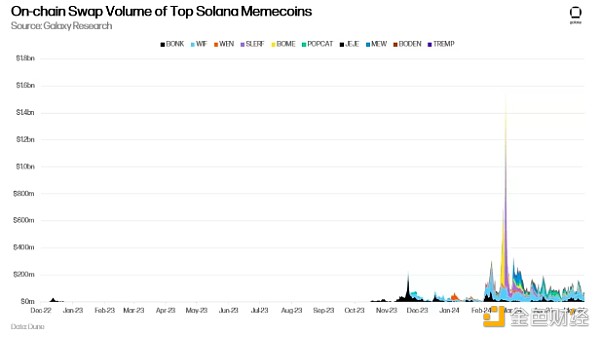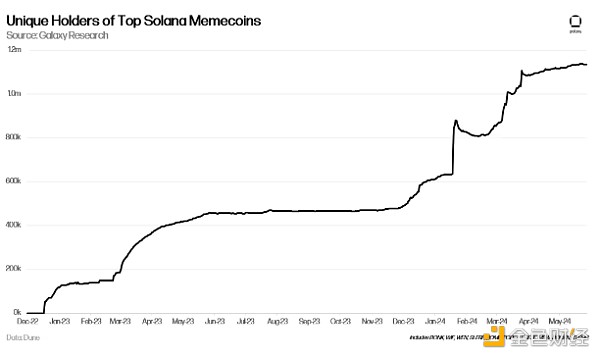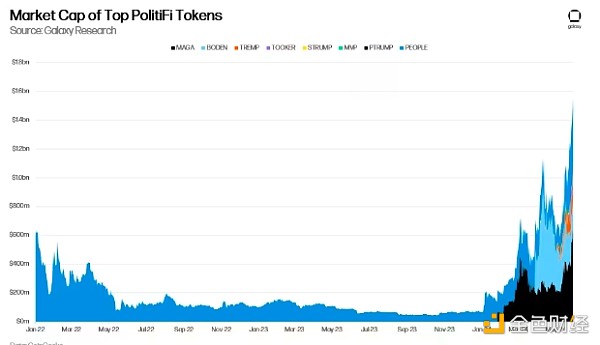Author: Zack Pokorny, Grayscale; Compiler: Bai Shui, Golden Finance
Whether you love it or hate it, Meme has become the cornerstone of the crypto economy. Meme is not known for technological innovation or pushing the boundaries of blockchain scaling, and some skeptics claim they have no value at all. Some builders of the blockchain ecosystem even believe that memes obscure their serious work and harm the overall brand and image of crypto. However, due to the viral nature of their spread, memes proliferated and accumulated significant value within the broader crypto market.
Fundamentally, a meme is an idea, symbol, or behavior that spreads within or between subcultures. History shows that memes have existed in human civilization for centuries in different forms and through different mediums. They are likely to continue to exist and be presented on the most widely used communication channels. The meme has risen significantly during the pandemic, with investors gathering on sites like r/wallstreetbets to express dissatisfaction with the status quo by investing in stocks that have been heavily shorted by Wall Street giants, most notably GameStop. Permissionless blockchain takes this phenomenon even further. Dogecoin may be the original meme, but the popularity of the meme has exploded in recent years. We estimate that the total market capitalization of Meme on permissionless blockchains currently exceeds $60 billion. The growth of memes builds on the monetary connections shared by NFT project holders and demonstrates how communities, cultures, groups, and trends may increasingly rely on monetary tools for cohesion and speculation.
Memes and expressions through the ages
Although the content of Meme and the information it conveys have changed with society It continues to evolve with changes in culture, culture, and technology, but the digital images we share and laugh at today are not inherently new. They are simply a continuation of something that has evolved with the earliest humans over thousands of years. Storytelling is an integral part of being human, and whether it's organic marketing or intentional propaganda, viral meme images, prose, and concepts have played an important role in the formation and change of human society. From cave paintings to Roman graffiti, from viral anonymous pamphlets to newspaper cartoons, widely shared images and concepts have conveyed knowledge, helped topple governments, and spurred social change throughout the ages.
While memes in this general sense have always existed, two important components have fundamentally changed throughout history: the medium in which they are expressed and the way they are disseminated. The oral traditions of ancient societies condensed complex histories into memorable, repeatable stories, which were essential for passing on knowledge to future generations. Viral images were widely used to convey political messages in ancient Greek and Roman societies, and as methods of creation and dissemination became more advanced and convenient, their influence grew. Blockchain is the next stage in Meme’s evolution as its technology is widely standardized, the ledger is permanent and uncensorable, and it is globally accessible.
The Evolution of the Meme Canvas
Since the dawn of humanity, the inherent desire to express and share experiences, emotions and ideas has been a driving force in communication and cultural development. The earliest humans carved their thoughts and observations onto cave walls and stone using only charcoal and chisels, creating the first known "Meme." These original memes are a testament to the fundamental human need for connection and the sharing of elements of culture and expression.
With the prosperity of civilization and the advancement of technology, the media depicting Meme are also constantly changing. Paint, ink, slate, and paper became the new canvases, and beautiful frescoes appeared in ancient public buildings, offensive graffiti appeared in the Colosseum, and caricatures appeared in newspapers.
The birth of the modern Internet meme in 1993 marked the final paradigm shift in the way we express and share our ideas. Through email and message boards, the digital realm became the new frontier in meme evolution, allowing individuals to engage with and share memes on a larger, more expressive scale.
Today, the emergence of Meme puts us on the verge of another transformative moment in the history of the canvas of expression and distribution, thereby also transforming human communication. The widespread use of blockchain as a canvas for Meme and peer-to-peer (P2P) networks as communication rails marks a new era of human communication and cultural evolution. . Just as the printing press revolutionized the spread of ideas (and eventually memes) in the 15th century, and television and the Internet revolutionized the spread of ideas in the 20th century, blockchain will redefine how we create in the 21st century , share and consume memes and information.
The evolution of Meme distribution
In the early days of human civilization, Meme was probably passed between people Although this process was not efficient for large-scale communication, it was the most advanced communication method at the time. As humans developed more sophisticated communication tools and technologies, such as writing, printing, and painting, memes became more widespread. Graffiti on building walls and paintings in public spaces make these cultural elements accessible to a wider audience, even if the meme itself remains limited in its transmissibility.
The emergence of newspapers marked an important milestone in human communication and the spread of memes in the form of comics and cartoons. While the creation of memes is more restricted in this medium, memes spread much easier due to the use of cars, bikes, and storefronts as communication channels. These means of transportation were one of the most important advances of the time, allowing information, ideas, and culture to spread rapidly to a wide audience.
The rise of television and the Internet ushered in a new era of meme dissemination, democratizing access to memes and allowing people to watch them from anywhere in the world. The privileges that once determined access to memes have been largely removed, as anyone with an internet connection or a television broadcast can participate and share these cultural elements. With the advancement of these technologies and their applications, the creation of Meme has become easier and easier, and the emergence of tools and platforms has promoted the production and dissemination of Meme.
Throughout history, Meme has always found its way into the most advanced, influential and widely adopted communication channels of its time. All of these have had a significant impact on humanity.
The adoption of blockchain as a medium for meme expression highlights the increasing importance of this technology as a central platform for sharing ideas and experiences in the purely digital era.
Meme on the blockchain
Memecoin is a token for Internet memes or other humorous events or concepts description. They are native assets to the blockchain, are transferable, can be used in blockchain-based applications, and can be traded on secondary markets such as DEXs. Memecoins are often represented by their code or string of letters that identify them, but also have characters or other visuals associated with them, much like what most people know as memes today. For example, Dogecoin, a Layer 1 blockchain created in 2013 to satirize Bitcoin, relies on a photo of a Shiba Inu that recently went viral online. Dogecoin is a fork of Bitcoin that was launched before the rise of tokenization, so $DOGE needs its own Layer 1 blockchain to exist. Today, existing Layer 1 blockchains (such as Ethereum, Solana, and even Bitcoin) are capable of hosting and issuing non-native tokens, and their ecosystems are equipped with out-of-the-box token contracts, decentralized exchanges and other tools to facilitate token issuance.
Behind every memecoin is a contract tied to a Layer 1 blockchain or Layer 2 network that specifies the memecoin’s name, supply, and other details outlining its digital identity. Memecoin can only be deployed by launching one of the token contracts. In the early days of blockchain, issuing tokens was mostly costly and difficult because it required technical skills to write or adjust contracts, issue tokens on the blockchain, and create liquidity pools on DEXs for people to trade. Today, many of the difficulties have been abstracted away by services that automatically issue tokens and create liquidity pools after users enter the details of their memecoin. Recently, Pump.Fun has become a popular place for memecoin issuance, but there are many ready-made token contracts that can be easily deployed on various blockchains. The relative ease of issuing memecoins has created a flywheel effect that has led to the creation of memecoins and speculation in them on an unprecedented scale.
Gambling as a means of distribution
Almost by definition, with rare exceptions, Meme coins No real practicality. While Dogecoin is the gas token used to purchase block space on the Dogecoin blockchain, Meme coins today are almost entirely worthless native gas tokens. Instead, meme coins are typically blockchain tokens without corresponding gas or application use, often promoted by creatives, held by the community, or speculated on by traders as a way to bet on the relative rise or fall in virality of the underlying meme itself. . Meme coins are extremely volatile due to their lack of underlying fundamental purpose, and their volatility serves as a vehicle to attract users, making them, and the blockchains that host them, more widely used and understood. The desire for crazy gains and instant wealth is the motivation for many people’s interest in Meme coins. The possibility of increasing financial wealth was the catalyst that initially (and to this day) drove the adoption of meme coins as a canvas for cultural and emotional expression on the blockchain.
Some say this is a flaw that suggests memecoins are temporary or will fade away as people make and lose money. However, as we pointed out, memes have always existed, and so has the desire to make a quick buck. While memes of the internet age have become ubiquitous, only recently have they become assets that can be monetized and traded. Blockchain tokenization combines the viral spread of powerful information with the human desire to seek wealth. This combination is new and will likely continue to be popular.
Meme Data
In this section of the report, we examine the on-chain activity and value driven by memecoins over the past few years.
Solana is the leading blockchain for memecoins in 2024. Solana’s low-fee environment lowers the barrier to entry for users to create and trade memecoins, and fast transaction confirmation speeds make using the blockchain an experience comparable to loading memes on an internet browser. The end of 2023 marks a turning point for memes’ existence on the chain. From August to November 2023, Solana added an average of approximately 9,000 tokens per day, and now averages 28,000 new tokens per day. That’s more than three times that number. At its peak, it was adding over 100,000 new coins per day using a 30-day moving average. While not all of these tokens are memecoins, the large meme culture that exists on Solana allows it to act as a proxy for memecoin creation in the crypto space.

Over the past 30 days, on-chain transaction volume for the top-ranked Solana memecoin by market cap has averaged between $91 million and $109 million. The top two Solana memecoins Bonk and WIF by market capitalization accounted for 59% of average trading volume during this period.

As transaction volume increases, the user base continues to expand. Solana’s ten major memecoins have a combined total of over 1.136 million unique holders. Note that this number treats addresses holding multiple memecoins as a single holder. The trend highlights the reach of memecoins and how quickly the trend spreads.

However, Meme coins It didn't start with Solana. $DOGE is one of the earliest and most valuable meme coins in cryptocurrencies, launched in 2013, and as of May 29, 2024, its value has reached $24 billion. $DOGE was launched on its own blockchain, the Dogecoin network. In addition to Dogecoin, Ethereum was the original platform for meme coins during the 2020-2022 cryptocurrency bull cycle. Ethereum is the birthplace of iconic memes like SHIB and, more recently, PEPE and Harry Potter Obama Sonic 10 Inu, playing an important role in allowing memes to gain a foothold on the blockchain. Even though activity on Ethereum has migrated to other networks, it still has the second- and third-largest meme coins in SHIB and PEPE.
As the number of Meme coins grows, so does their size. As of May 29, 2024, the total value of top memecoins was $57 billion, a 3.5x increase from the same period last year and a 4.8x increase from the bear market low. An interesting feature of this chart is that four of the seven memecoins pictured were created within the last 511 days of May 29, 2024; two of the seven memecoins were launched within 160 days. This highlights memecoins’ rapidly changing nature and lack of staying power due to the rapid evolution of today’s human and internet culture.

As time goes by, people become more and more accustomed to using blockchain as a cultural exchange platform, and the types of memes that appear on the chain have become more specific, ranging from mainly dog and animal coins to expressions of political beliefs and opinions. memecoin. This shift shows that blockchain is becoming a more important means of communication, with memes as the main vehicle. The chart below tracks the total market capitalization of the top “PolitiFi” tokens, or memecoins depicting political figures and symbols.
These types of memes did not appear on the blockchain until 2024, the year of the 60th quadrennial presidential election in the United States. Memecoins representing political figures have been largely non-existent in the past, although they have existed for several election cycles. However, some politicians, such as former US President Donald Trump, have experimented with NFTs in the past.

Unobvious Memecoin Utility
While memecoins generally do not offer any specific utility as assets - they are not used to purchase block space like native Layer 1 assets, and rarely have any governance or application utility - Some have resulted in significant secondary activity. For example, the dog-themed memecoin $BONK was launched on Solana shortly after the FTX crash in late 2022. Due to its close association with Sam Bankman-Fried and FTX, the usage of the Solana blockchain has dropped significantly. $SOL itself, the native token of the Solana blockchain, has lost 86% in value from its all-time high in November 2021, but fell another 78% between the FTX crash and early 2023. $BONK was originally created to reignite interest in Solana and catalyze on-chain activity by providing support to Solana developers, application users, and NFT Holders receive free memecoin airdrops. And it works, aside from the huge price increase, $BONK has been incorporated since launch Solana ecosystem with over 129 integrations in DeFi, gaming, NFTs, and other types of on-chain applications; became a major sponsor of Solana and non-Solana related social/cultural events; and developed its own bonk-specific application , such as Bonk AMM, vesting contracts, and even the gamified fitness app Moonwalk.
Memecoins can also act as a pipeline of liquidity flowing through newly designed applications. The decentralized exchanges and DeFi applications that serve memecoins today could become the infrastructure that powers more traditional tokenized markets in the future. Just as MakerDAO is an application that allows users to convert ETH into stablecoins, but is now one of the main ways for traditional asset issuers to bring US Treasury bonds to the chain, memecoin’s explosive growth may also lead to the development and evolution of new application primitives, driving more sustained blockchain adoption in the future.
Conclusion
In 2024, Two main segments drive most of the traffic and interest in the cryptocurrency market: Bitcoin (especially considering the launch of spot BTC ETPs in the United States) and memecoins. Other important segments such as NFTs, DeFi, and gaming continue to grow and develop, but their tokens have mostly underperformed and the market has yet to adopt them as a driving narrative. Newer technology concepts are still at the forefront of people's minds, such as modularity and re-staking, but they are mostly not launched yet. Bitcoin’s continued outperformance and growing institutional adoption continue to be a powerful macro cryptocurrency narrative, but the strongest crypto on the market today The currency’s native narrative is memecoins.
While many consider memecoins to be nihilistic and inherently useless , but their existence is built on generations of viral stories, and their activity continues to drive blockchain adoption. The important role of their presence on the chain is not so much how much they are supposed to be worth, but that the blockchain is used as a communication channel to disseminate them – as they are expected to become a wider channel of expression for society. As blockchain gains traction as a means of communication and cultural exchange, the fusion of Meme and technology puts this new medium on par with media such as newspapers, cars, television and the Internet, all of which All have had a huge impact on humanity and have become globally adopted technologies.
 JinseFinance
JinseFinance
 JinseFinance
JinseFinance JinseFinance
JinseFinance JinseFinance
JinseFinance Beincrypto
Beincrypto dailyhodl
dailyhodl Others
Others Others
Others Bitcoinist
Bitcoinist Cointelegraph
Cointelegraph Cointelegraph
Cointelegraph